
Equidae is the taxonomic family of horses and related animals, including the extant horses, asses, and zebras, and many other species known only from fossils. All extant species are in the genus Equus, which originated in North America. Equidae belongs to the order Perissodactyla, which includes the extant tapirs and rhinoceros, and several extinct families.
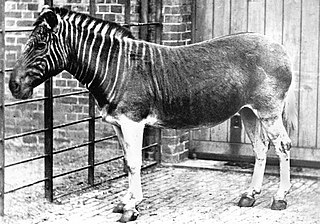
The quagga is a subspecies of the plains zebra that was endemic to South Africa until it was hunted to extinction in the late 19th century. It was long thought to be a distinct species, but early genetic studies have supported it being a subspecies of plains zebra. A more recent study suggested that it was the southernmost cline or ecotype of the species.
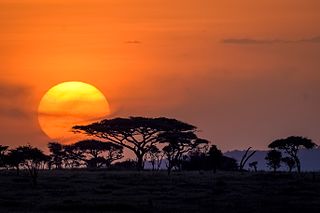
The Serengeti ecosystem is a geographical region in Africa, spanning northern Tanzania. The protected area within the region includes approximately 30,000 km2 (12,000 sq mi) of land, including the Serengeti National Park and several game reserves. The Serengeti hosts the second largest terrestrial mammal migration in the world, which helps secure it as one of the Seven Natural Wonders of Africa, and as one of the ten natural travel wonders of the world.
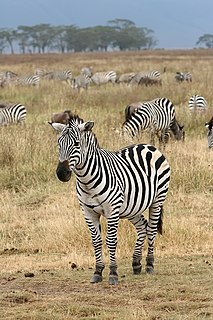
Zebras are African equines with distinctive black-and-white striped coats. There are three living species: the Grévy's zebra, plains zebra, and the mountain zebra. Zebras share the genus Equus with horses and asses, the three groups being the only living members of the family Equidae. Zebra stripes come in different patterns, unique to each individual. Several theories have been proposed for the function of these stripes, with most evidence supporting them as a deterrent for biting flies. Zebras inhabit eastern and southern Africa and can be found in a variety of habitats such as savannahs, grasslands, woodlands, shrublands, and mountainous areas.

The onager, also known as hemione or Asiatic wild ass, is a species of the family Equidae native to Asia. A member of the subgenus Asinus, the onager was described and given its binomial name by German zoologist Peter Simon Pallas in 1775. Five subspecies have been recognized, one of which is extinct.

The plains zebra, also known as the common zebra, is the most common and geographically widespread species of zebra. Its range is fragmented, but spans much of southern and eastern Africa south of the Sahara. Six or seven subspecies have been recognised, including the extinct quagga which was thought to be a separate species. More recent research supports variations in zebra populations being clines rather than subspecies.

The mountain zebra is a zebra species in the family Equidae, native to southwestern Africa. There are two subspecies, the Cape mountain zebra found in South Africa and Hartmann's mountain zebra found in south-western Angola and Namibia.
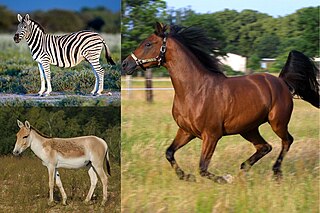
Equus is a genus of mammals in the family Equidae, which includes horses, donkeys, and zebras. Within the Equidae, Equus is the only recognized extant genus, comprising seven living species. Like Equidae more broadly, Equus has numerous extinct species known only from fossils. The genus most likely originated in North America and spread quickly to the Old World. Equines are odd-toed ungulates with slender legs, long heads, relatively long necks, manes, and long tails. All species are herbivorous, and mostly grazers, with simpler digestive systems than ruminants but able to subsist on lower-quality vegetation.

The Ngorongoro Conservation Area is a protected area and a UNESCO World Heritage Site located in Ngorongoro District, 180 km (110 mi) west of Arusha City in Arusha Region, within the Crater Highlands geological area of northern Tanzania. The area is named after Ngorongoro Crater, a large volcanic caldera within the area. The conservation area is administered by the Ngorongoro Conservation Area Authority, an arm of the Tanzanian government, and its boundaries follow the boundary of the Ngorongoro District in Arusha Region. The western portion of the park abuts the Serengeti National Park, and the area comprising the two parks and Kenya's Maasai Mara game reserve is home to Great Migration, a massive annual migration of millions of wildebeest, zebras, gazelles, and other animals. The conservation area also contains Olduvai Gorge, one of the most important paleoanthropological sites in the world.

Grévy's zebra, also known as the imperial zebra, is the largest living wild equid and the most threatened of the three species of zebra, the other two being the plains zebra and the mountain zebra. Named after Jules Grévy, it is found in parts of Kenya, Somalia and Ethiopia. Superficially, Grévy's zebras’ physical features can help to identify it from the other zebra species; their overall appearance is slightly closer to that of a mule, compared to the more “equine” (horse) appearance of the plains and mountain zebras. Compared to other zebra species, Grévy’s are the tallest; they have mule-like, larger ears, and have the tightest stripes of all zebras. They have distinctively erect manes, and more slender snouts.

Burchell's zebra is a southern subspecies of the plains zebra. It is named after the British explorer and naturalist William John Burchell. Common names include bontequagga, Damaraland zebra, and Zululand zebra. Burchell's zebra is the only subspecies of zebra which may be legally farmed for human consumption.

The Quagga Project is an attempt by a group in South Africa to use selective breeding to achieve a breeding lineage of Burchell's zebra which visually resemble the extinct quagga.

The blue wildebeest, also called the common wildebeest, white-bearded gnu or brindled gnu, is a large antelope and one of the two species of wildebeest. It is placed in the genus Connochaetes and family Bovidae, and has a close taxonomic relationship with the black wildebeest. The blue wildebeest is known to have five subspecies. This broad-shouldered antelope has a muscular, front-heavy appearance, with a distinctive, robust muzzle. Young blue wildebeest are born tawny brown, and begin to take on their adult coloration at the age of 2 months. The adults' hues range from a deep slate or bluish-gray to light gray or even grayish-brown. Both sexes possess a pair of large curved horns.

Lord Morton’s mare was an equid hybrid and once an often-noticed example in the history of evolutionary theory.

The wildlife of Zambia refers to the natural flora and fauna of Zambia. This article provides an overview, and outline of the main wildlife areas or regions, and compact lists of animals focusing on prevalence and distribution in the country rather than on taxonomy. More specialized articles on particular groups are linked from here.

Crawshay's zebra is a subspecies of the plains zebra native to eastern Zambia, east of the Luangwa River, Malawi, southeastern Tanzania, and northern Mozambique south to the Gorongoza District. Crawshay's zebras can be distinguished from other subspecies of plains zebras in that its lower incisors lack an infundibulum. Crawshay's zebra has very narrow stripes compared to other forms of the plains zebra.

Chapman's zebra, named after its describer James Chapman, is a subspecies of the plains zebra.
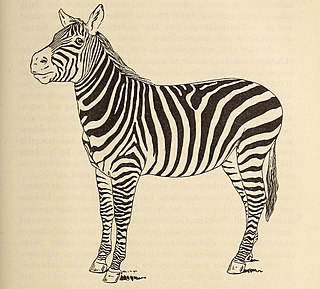
Selous' zebra is a subspecies of the plains zebra distributed across southeastern Africa. It is found mostly in Mozambique.

Khumba is a 2013 South African computer-animated comedy film directed and co-produced by Anthony Silverston and written by Silverston and Raffaella Delle Donne. The film stars the voices of Jake T. Austin, Steve Buscemi, Loretta Devine, Laurence Fishburne, Richard E. Grant, AnnaSophia Robb, Anika Noni Rose, Catherine Tate, Ben Vereen, and Liam Neeson. It is the second movie made by Triggerfish Animation Studios and is distributed by Millennium Entertainment in the US. The International distribution rights are being licensed by Cinema Management Group. The film is about Khumba, a zebra who is half-striped like a quagga and blamed for the lack of rain by the rest of his insular, abusive, superstitious herd, except his dad, mom and Tombi. He embarks on a quest to earn his stripes.

The maneless zebra is a subspecies of the plains zebra spread over the northern parts of eastern Africa. It ranges in northwestern Kenya to the Karamoja district of Uganda. It is also found in eastern South Sudan, east of the White Nile. It is the northernmost subspecies of the plains zebra. The last remaining substantial population is in Kidepo Valley National Park.



























